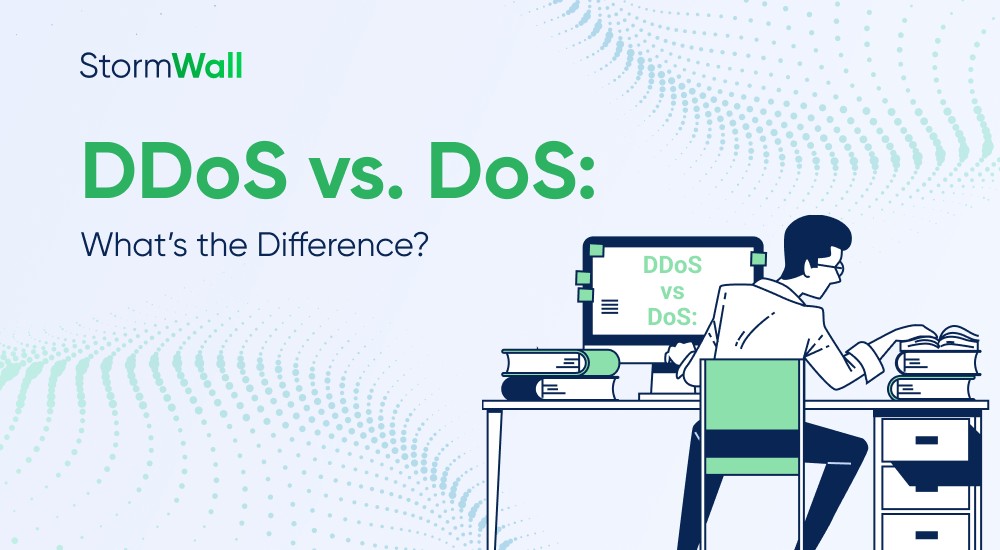Hackers are increasingly targeting websites and online services to take them offline—this is confirmed by our latest DDoS reports. Cyberattacks are becoming more sophisticated and dangerous: over the past few years, their mechanisms have grown significantly more complex. In this article, we’ll break down the difference between DoS and DDoS attacks—and share how to protect your infrastructure against both.

Key Differences Between DoS and DDoS
To visualize the difference between DoS and DDoS attacks, imagine a football game. A DoS attack is like a single player running toward the goal with one ball. A DDoS attack? It’s dozens of balls flying in from all directions—opponents and even fans in the stands.
DoS Attacks
The term DoS stands for Denial of Service. These attacks are considered the “original” form of service disruption—they’ve been around since the 1970s–1980s, before the era of mass computerization.
In a DoS attack, hackers use a single device or server to flood a victim’s infrastructure with a high volume of requests. This traffic exceeds the capacity of the target’s network or server, causing it to overload and become unavailable to users.
DoS attacks are typically targeted at a specific system or network and are relatively easy to detect—a quick look at the server logs is often enough to identify the malicious IP address.
DoS Attack Example
Just before Christmas, the website of an online store selling live Christmas trees and holiday decorations suddenly went down. At first, the owners assumed it had simply crashed under high seasonal traffic. But the system administrator soon discovered that a large volume of requests was coming from a single domain.Most likely, the attack was launched by competitors hoping to prevent users from placing holiday orders and redirect them to their own store. The admin responded by blocking the suspicious domain through the store’s firewall—and the issue was resolved.
Today, DoS attacks are less common, but they still occur—mainly in local incidents or as training grounds for beginner hackers.
DDoS Attacks
DDoS attacks emerged as technology advanced and hardware capacity grew. The extra “D” in “DDoS” stands for Distributed, meaning that hackers use multiple devices simultaneously. The more devices involved, the more requests are sent—and the more powerful the attack.
Also read: What Is a DDoS Attack and How to Protect Against It?
To launch a large-scale DDoS attack, hackers build botnets—networks of internet-connected devices. These include hacked computers, phones, routers, cameras, smartwatches, and other gadgets. Malicious software is secretly installed on them, causing the devices to send harmful traffic—without their owners even knowing.
Another option is a human-powered botnet, where thousands of hacktivists coordinate to flood a target’s infrastructure.
Here’s how it works: the botnet overwhelms a server with traffic from many sources. The server can’t handle the load and crashes. Hackers may target a specific website, data channel, or the entire IT infrastructure—the only limit is their firepower.
Also read: How Botnets Are Used in DDoS Attacks
DDoS Attack Example
A major hosting provider suddenly loses connection to its data center. Clients begin reporting that all their websites are offline. Technical analysis reveals the issue isn’t a hardware failure, but a coordinated DDoS attack.
Thousands of infected devices across the globe (a botnet) are simultaneously bombarding the provider’s networking equipment with malicious traffic. The internet channel is completely overloaded with junk requests. Blocking individual IP addresses is pointless—there are tens of thousands of them. How did they solve it? Read the success story of Limitis to find out.
Why Attackers Use Both Methods
The main goal of both DoS and DDoS attacks is to disrupt the normal functioning of a website, service, or network—making it slow or completely unavailable. Typical symptoms include sluggish loading, malfunctioning features, or full-scale service outages. As a result, businesses suffer financial losses and damage to their reputation.
Why do cybercriminals launch these attacks? There are many motivations behind DoS and DDoS:
- Competitor sabotage—attacks ordered to undermine a rival’s business;
- Extortion—hackers demand money to stop the attack or to restore stolen data;
- Hacktivism—politically or socially motivated protests, with no financial gain involved;
- Distraction—the attack is just a smokescreen; the real goal is to infiltrate the infrastructure or steal data;
- Revenge or personal grudge—for example, a disgruntled former employee takes down company systems;
- Ego and entertainment—some hackers launch attacks simply to show off their skills or cause chaos for fun.
Also read: Why DDoS Attacks Happen
Why DDoS Is More Dangerous Than DoS
Here’s why DDoS attacks are significantly more dangerous than DoS:
1. Distributed nature: A DoS attack comes from one source. A DDoS attack originates from thousands of IP addresses scattered across the globe. With DoS, it’s often enough to block a single IP or apply geo-blocking to mitigate the threat. With DDoS, attackers will keep coming from different locations until your servers or website are overwhelmed.
2. Massive scale: A DoS attack is limited by the power of a single device. Most modern hosting services can withstand that level of pressure. A DDoS attack, however, is often powered by huge botnets capable of generating traffic that overwhelms even large-scale infrastructure.
3. Harder to detect: A sudden traffic spike from one IP is easy to notice in server logs or analytics. DDoS bots mimic legitimate users, spread requests over time, and use legitimate-looking devices like webcams or routers. This makes it much harder to distinguish real traffic from malicious traffic.
4. Available as a service on the dark web: Organizing a DoS attack isn’t cost-effective: renting one powerful server is expensive and easily traceable. DDoS-for-hire services thrive in the dark web: anyone can rent a botnet, pay in crypto, and launch an attack anonymously—with no special skills required.
5. Long-term impact on business: A DoS attack can typically be handled quickly. A well-orchestrated DDoS attack can cripple an entire infrastructure, leading to: lost revenue, legal penalties, customer churn, and long-lasting reputational damage that takes months or years to rebuild.
Also read: The Business Impact of DDoS Attacks
Let’s summarize the key differences between DoS and DDoS attacks:
| DoS Attack | DDoS Attack | |
| Source | Single computer/system | Distributed network (botnet) |
| Attack power | Up to 10 Gbps | Can reach 1 Tbps or more |
| Detection | Easy | Difficult |
| Protection | Can be mitigated without specialized tools | Requires advanced protection from a specialized provider |
DDoS attacks are an evolutionary step beyond traditional DoS—larger in scale and more dangerous. Protecting your resources against them requires a strategic approach to infrastructure and robust professional solutions.
If you’re looking for reliable anti-DDoS services, reach out to StormWall—we’re here to help.

DDoS Protection for Websites
- Activate protection in 10 minutes
- 24/7 technical support




















